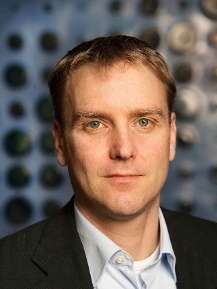Biography
After receiving his master’s degree in chemistry at Utrecht University, Peter Bolhuis performed a PhD at the AMOLF institute. He graduated cum laude at Utrecht University in 1996. After two postdoctoral fellowships in Berkeley and Cambridge, he initiated his own research line on biomolecular simulations in the early 2000s, and became full professor in 2006. He is currently head of the computational chemistry theme at HIMS, and director of ACMM. From 2019 to 2021 he was also scientific director of HIMS.
Research interests
My group is interested in developing and applying novel simulation methodologies for studying complex (bio)molecular systems, such as folding of proteins, biomolecular isomerisation, self-assembly and nucleation events. To achieve insight in these processes we conduct multiscale modeling simulations of biomolecular systems using rare event- and coarse graining techniques. In addition we continue developing new and advanced simulation methodology such as Transition Path Sampling, free energy calculations, multscagle modelling. Read more about our projects on the research topics pages.
Transition path sampling methods
Transtion path sampling (TPS) was developed to harvest an ensemble unbiased dynamical reactive pathways. In the past years we have contributed to the development of the TPS framework, for instance, by further developing the Transition interface sampling to compute rate constants, and optimizing reaction coordinates. All of this culminated in the development of the OpenPathSampling python package.
Nulceation of methane hydrates
Methane hydrates form spontaneously in methane/water mixtures under high pressure. The mechanism of formation by homogenous nucleation at moderate temperatures is still an open question. Previous simulation work necessarily focused on high undercooling conditions, or used coarse-grained water models that result in amorphous solid states instead of the experimentally found crystalline sI structure. This has led to multiple nucleation mechanism hypotheses. We apply Transition Path Sampling to elucidate the nucleation mechanism of methane hydrates at moderate conditions, and temperatures close to experimental values.
Active Soft Matter
Structural architectures in living cells, such as the cytoskeleton in muscle or plant tissue, are both viscoelastic and active, i.e. undergo continuous injection of energy, leading to remarkable collective, non-equilibrium properties. The thermodynamics, kinetics and statistical mechanics of such systems are far from understood. While active fluids (swarms, swimmers) have seen an explosion of interest recently, their solid (elastic) counterparts remain completely unexplored and understanding such phenomena remains one of the grand challenges of modern statistical physics.
Patchy particles provide a model system for exploring complex molecular structures with high controllability. Patchy particles are micron-sized colloidal particles dressed with patches that are able to form bonds under specific solvent compositions and temperatures. While patchy particles are big enough to be observed in experiment under e.g. a confocal microscope, they are small enough to exhibit similar statistical behavior as atoms and molecules. In addition, patchy particles are a mesoscopic structural analogue of carbon atoms. Divalent patchy particles make linear bonds like sp hybridized carbon atoms and act as monomers forming chains as shown in the background. Tetravalent patchy particles make tetrahedral bonds and may form rings with a half-chair or envelope conformation like cyclopentane. In collaboration with the experimental Soft Matter group we explore active patchy particle architectures, by using advanced simulation methods, including path sampling
Novel techniques for rare events
We develop new techniques for rare event simulations. These include Transition interface sampling and variants thereof, such as Replica Exchange TIS, Single replica TIS, and Virtual interface exchange.
